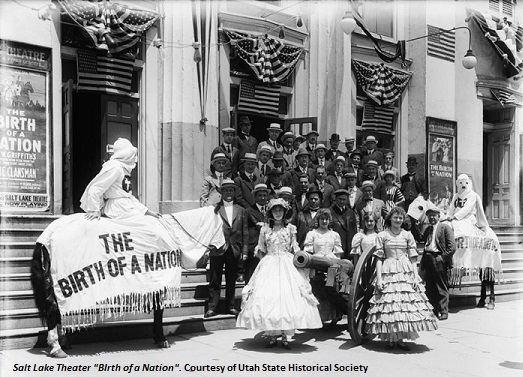Dublin Core
Title
Description
The presence of the Ku Klux Klan was not just limited to the southern United States. In fact, the KKK had grown enough to march through the streets of Salt Lake City in the early 1920s.
In 1922, a small crowd of hooded and caped Ku Klux Klansmen crashed the funeral of deputy Salt Lake County sheriff Gordon Stuart. Marching to Stuart's grave site in the form of a cross, the Klansmen paid silent homage to Stuart, who had been killed in the line of duty, and then were whisked away in two unmarked cars. It's still unclear why representatives of the Klan showed up at Stuart's graveside service. Perhaps Stuart was a member of the group. Or maybe the Klansmen were simply trying to show that they were on the side of law and order. One thing is certain, however. The public display made by the Klan at Stuart's funeral was not unique in early-twentieth-century Utah.
The Ku Klux Klan made its initial appearance in Utah around 1921, as part of the group's nationwide resurgence following its first iteration in the 1870s. Within a few years, Klansmen had grown bold enough to march through the streets of Salt Lake and burn crosses on immigrant lawns as a form of public intimidation. The most violent of the Utah Klan's activities, however, may have been the lynching of African American miner Robert Marshall in CarbonCounty. Arrested on flimsy evidence for murdering lawman J. Milton Burns, Marshall was hauled to a farm between Price and Wellington by a lynch mob and hanged. According to historian Larry Gerlach, it was an open secret in the county that Burns and the eleven men who were eventually charged with killing Marshall were members of the Ku Klux Klan. Unfortunately, no one was ever convicted of Marshall's murder, but the crime did bring public pressure to bear on the Klan. Anti-mask laws and other public ordinances that targeted the Klan pushed the group underground. By the 1930s, the Utah Klan had effectively died out.
Creator
Source
Image: Salt Lake Theater "Birth of a Nation". June 14, 1916. Image shows a group of people, two of whom are in Ku Klux Klan costumes, posing for a photograph outside the Salt Lake Theater. They are advertising for a showing of the first moving picture, "Birth of a Nation." Courtesy of Utah State Historical Society.
_______________
See the September 1995 collection of the History Blazer, a joint project of the Utah State Historical Society and the Utah State Centennial Commission. The History Blazer can be found on the Utah History Suite CD available from the Utah State Historical Society. Also see Larry R. Gerlach, Blazing Crosses in Zion: The Ku Klux Klan in Utah (Logan: Utah State University Press, 1982).

